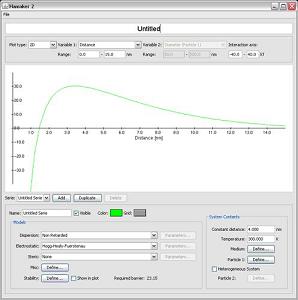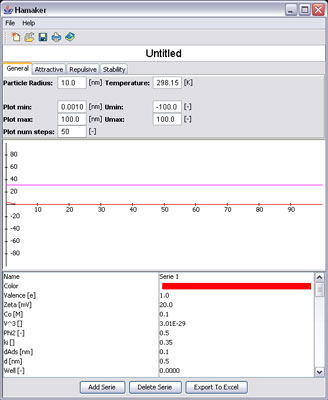The prediction and control of interparticle forces in suspensions play a critical role in the production of high quality ceramics as agglomeration and thus green body density is dependant on the interactions present. Also the processing time window of a ceramic suspension depends on the stability and finally on the forces between the particles in suspension.
The original code Hamaker is still available (see below) but has been replaced by the much improved version Hamaker2 [1].
This work has been undertaken in the scope of the European Sixth Framework Integrated Project Nanoker No. NMP3-CT-2005-515784
Hamaker2
 Hamaker2 [1] is a much improved version of the original code. The major improvements are:
Hamaker2 [1] is a much improved version of the original code. The major improvements are:
– Heterogeneous systems (materials and sizes)
– Finer control over variables
– Can plot as a function of any variable
– 3D plots as a function of two variables
– Much cleaner user interface
– Extensible by plug-ins
In order to download this new and enhanced version, please visit the download page.
Hamaker1
 The computer code “Hamaker” was developed with the aim of combining certain pre-existing interparticle force codes at LTP in a unified and fashion in an easy to use graphical interface. Hamaker implements different models for dispersion forces (Non Retarded, Gregory, Bergström, Vincent), the electrostatic forces (HHF, LSA, SA, Venegol) as well as the steric forces (Bergström) based on parameters such as the particle size, the temperature, valance, zeta potential, ionic concentration and adsorbed polymer properties. The program contains a simple estimation for the energy barrier required for stability of the suspension for a certain period of time.
The computer code “Hamaker” was developed with the aim of combining certain pre-existing interparticle force codes at LTP in a unified and fashion in an easy to use graphical interface. Hamaker implements different models for dispersion forces (Non Retarded, Gregory, Bergström, Vincent), the electrostatic forces (HHF, LSA, SA, Venegol) as well as the steric forces (Bergström) based on parameters such as the particle size, the temperature, valance, zeta potential, ionic concentration and adsorbed polymer properties. The program contains a simple estimation for the energy barrier required for stability of the suspension for a certain period of time.
In order to assure operating system independence the code was developed in the Java language and can be downloaded using the link below.
The zipped file contains the java archive to be double clicked in order to start the program as well as a pdf version of the manual.
Publications
[1] Aschauer U., Burgos-Montes O., Moreno R., Bowen P., Hamaker 2: A toolkit for the calculation of particle interactions and suspension stability and its application to mullite synthesis by colloidal methods, Journal of Dispersion Science and Technology, accepted
